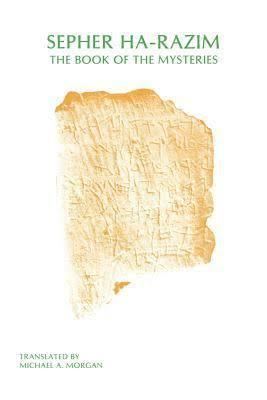8.4 /10 1 Votes
| 4.2/5 Goodreads | |||||||||||||||||||||||||||||||||
 | ||||||||||||||||||||||||||||||||||
Similar Bahir, Sefer Yetzirah, Shaar HaGilgulim, The Sword of Moses, Shi'ur Qomah | ||||||||||||||||||||||||||||||||||
The Sepher Ha-Razim is a Jewish mystical text supposedly given to Noah by the angel Raziel, and passed down throughout Biblical history to Solomon, for whom it was a great source of his wisdom, and purported magical powers. Note that this is a different book than the Sefer Raziel HaMalach, which was given to Adam by the same angel, but they stem from the same tradition, and large parts of Sepher ha-Razim were incorporated into the Sepher Raziel under its original title. This is an unorthodox text; while traditional Jewish laws of purity are part of the cosmogony, there are "praxeis which demand we eat cakes made from blood and flour" (Morgan 9). It is thought to be a sourcebook for Jewish magic, calling upon angels rather than God to perform supernatural feats. The text itself was once considered to be part of "orthodox" Judaism under the influence of Hellenism, but this text, along with some other works, are considered to be unorthodox or heretical in modern Judaism.
Contents
Discovery
The text was rediscovered in the 20th century by Mordecai Margalioth, a Jewish scholar visiting Oxford in 1963, using fragments found in the Cairo Geniza. He hypothesised that several fragments of Jewish magical literature shared a common source and was certain that he could reconstruct this common source. He achieved this in 1966 when he published Sepher Ha-Razim. The first English translation of the book was undertaken by Michael A. Morgan in 1983; the book is now in print, as of summer 2007. A new scholarly edition of the main extant manuscript witnesses including Hebrew and Judaeo-Arabic Geniza fragments and a 13th-century Latin translation was prepared by Bill Rebiger and Peter Schäfer in 2009, with plans for a translation and commentary in German.
Dating
Margalioth places the date of the original text to the early fourth or late third century CE. This date is almost universally accepted; a notable exception is Ithamar Gruenwald who dates the text to the sixth or seventh century CE. Nonetheless, it is clear that this text predates Kabbalistic texts, including the Zohar (thirteenth century CE), the Bahir (thirteenth century CE as well), and possibly the proto-Kabbalistic Sefer Yetzirah (fourth century CE). There are certain textual clues that point toward this early date, specifically the reference to "the Roman indictions in 1:27-28 [which] gives a clear terminus a quo of 297 CE" (Morgan 8).
Structure and content
The book is split into seven sections, not including a preface which details the book's reception and transmission. Each of the first six sections corresponds to one heaven and contains a listing of angels and instructions to perform one or more magical rites. Only the throne of God and the four hayots are in the seventh heaven. There is an uneasy tension between the orthodox cosmogony of the book and the unorthodox praxeis embodied in these magical rites; the book has obviously been edited by a rabbinical scribe, but the "popular religion" contained in the book is more or less intact. Some of the rituals purport to facilitate healing, prophecy, an attack upon one's enemy, and gaining good fortune. The number seven, the importance of divine names, and the prevalence of sympathetic magic all have significance in the literature of Ancient Near Eastern magic. The text demonstrates strong syncretism of Jewish and Greek traditions; an example is a prayer to the sun god Helios to invoke him at night:
“Holy Helios, who rises in the east, good mariner, trustworthy leader of the sun’s rays, reliable witness, who of old didst establish the mighty wheel of the heavens, holy orderer, ruler of the axis of heaven, Lord, Brilliant Leader, King, Soldier. I, N son of N, present my supplication before you, that you will appear to me without causing me fear, and you will be revealed to me without causing me terror, and you will conceal nothing from me, and will tell me truthfully all that I desire.”
The prayer is preceded by instructions to call on several angels 21 times as well as the name of the sun. The reader is told to perform the ritual in white garments.
